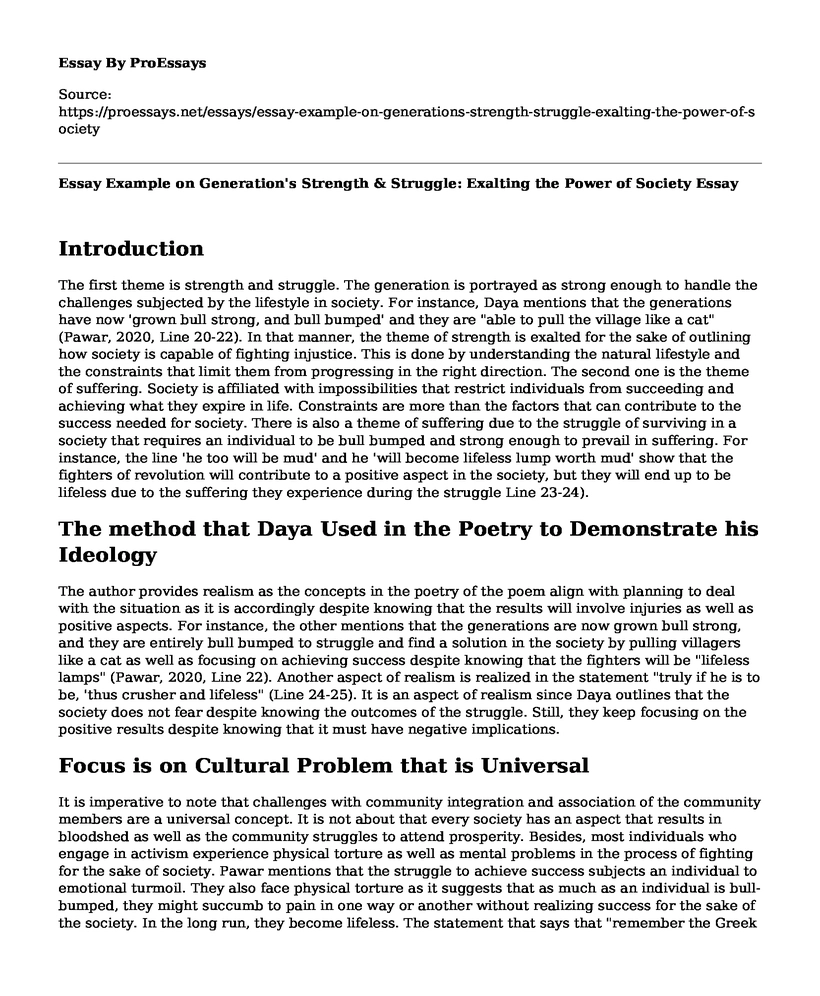Introduction
The first theme is strength and struggle. The generation is portrayed as strong enough to handle the challenges subjected by the lifestyle in society. For instance, Daya mentions that the generations have now 'grown bull strong, and bull bumped' and they are "able to pull the village like a cat" (Pawar, 2020, Line 20-22). In that manner, the theme of strength is exalted for the sake of outlining how society is capable of fighting injustice. This is done by understanding the natural lifestyle and the constraints that limit them from progressing in the right direction. The second one is the theme of suffering. Society is affiliated with impossibilities that restrict individuals from succeeding and achieving what they expire in life. Constraints are more than the factors that can contribute to the success needed for society. There is also a theme of suffering due to the struggle of surviving in a society that requires an individual to be bull bumped and strong enough to prevail in suffering. For instance, the line 'he too will be mud' and he 'will become lifeless lump worth mud' show that the fighters of revolution will contribute to a positive aspect in the society, but they will end up to be lifeless due to the suffering they experience during the struggle Line 23-24).
The method that Daya Used in the Poetry to Demonstrate his Ideology
The author provides realism as the concepts in the poetry of the poem align with planning to deal with the situation as it is accordingly despite knowing that the results will involve injuries as well as positive aspects. For instance, the other mentions that the generations are now grown bull strong, and they are entirely bull bumped to struggle and find a solution in the society by pulling villagers like a cat as well as focusing on achieving success despite knowing that the fighters will be "lifeless lamps" (Pawar, 2020, Line 22). Another aspect of realism is realized in the statement "truly if he is to be, 'thus crusher and lifeless" (Line 24-25). It is an aspect of realism since Daya outlines that the society does not fear despite knowing the outcomes of the struggle. Still, they keep focusing on the positive results despite knowing that it must have negative implications.
Focus is on Cultural Problem that is Universal
It is imperative to note that challenges with community integration and association of the community members are a universal concept. It is not about that every society has an aspect that results in bloodshed as well as the community struggles to attend prosperity. Besides, most individuals who engage in activism experience physical torture as well as mental problems in the process of fighting for the sake of society. Pawar mentions that the struggle to achieve success subjects an individual to emotional turmoil. They also face physical torture as it suggests that as much as an individual is bull-bumped, they might succumb to pain in one way or another without realizing success for the sake of the society. In the long run, they become lifeless. The statement that says that "remember the Greek myth" that outlines that as soon "as the cord is cut," an individual "burns in the leaping flames" (Pawar, 2020, Lines 26-29). For that reason, it is a universal that in every society the freedom fighters end up suffering even though they can achieve success for the society. Success is not achieved without bloodshed and suffering.
Comparison of Blood-Wave to "Spite" and "OAS"
In "Spite," the author narrates the life aspects of Homeland. The poem also incorporates universal ideas about being an expatriate and how society needs someone in one way or another to make them succeed or achieve a particular benefit. It is also associated with Data's concepts in the poem, blood-wave. On the other hand, "OAS" communicates about universal ideas of servant leadership and how the United States president always focused on serving people for the benefit of the society even though the society subjected them to multiple social constraints. For that reason, social suffering is a universal concept in all societies.
References
Pawar, D. (2020). Blood-wave [Blog]. http://marathidalitpoetry.blogspot.com/2014/07/blood-wavedaya-pawar.html
Cite this page
Essay Example on Generation's Strength & Struggle: Exalting the Power of Society. (2023, Aug 16). Retrieved from https://proessays.net/essays/essay-example-on-generations-strength-struggle-exalting-the-power-of-society
If you are the original author of this essay and no longer wish to have it published on the ProEssays website, please click below to request its removal:
- Research Paper on Single-Parent Families and Effects on Children
- Spirituality and Ethics of Human Cloning Essay Example
- Article Review: Information in Communicative Planning
- The Black Americans Community's Determinants of Health Essay Example
- Gender Bias for Women in Prison - Research Paper
- Essay Example on Karl Marx: Two Social Classes & Communist Manifesto
- Free Report Example on Exploring Dual-Income Families







